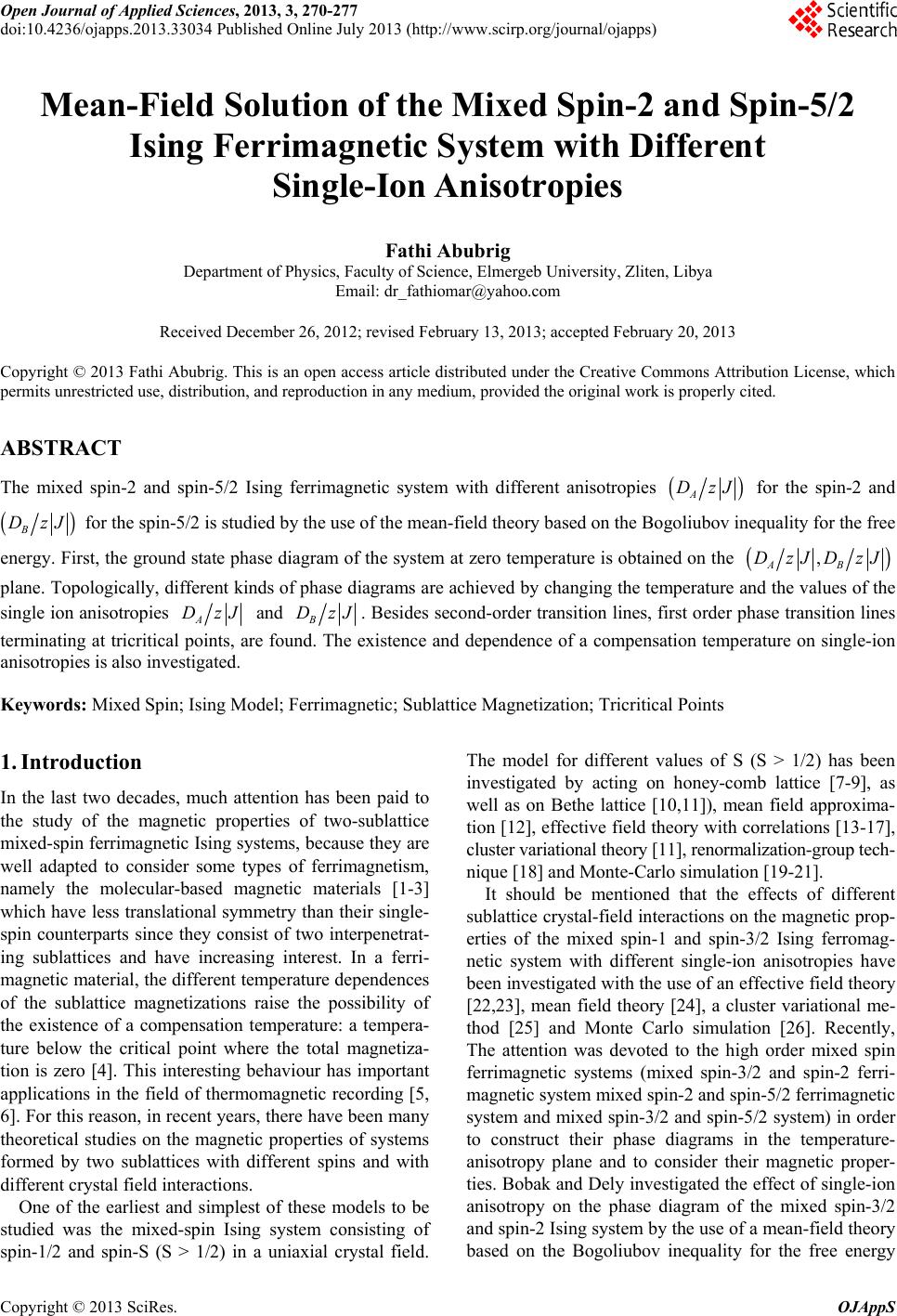 Open Journal of Applied Sciences, 2013, 3, 270-277 doi:10.4236/ojapps.2013.33034 Published Online July 2013 (http://www.scirp.org/journal/ojapps) Mean-Field Solution of the Mixed Spin-2 and Spin-5/2 Ising Ferrimagnetic System with Different Single-Ion Anisotropies Fathi Abubrig Department of Physics, Faculty of Science, Elmergeb University, Zliten, Libya Email: dr_fathiomar@yahoo.com Received December 26, 2012; revised February 13, 2013; accepted February 20, 2013 Copyright © 2013 Fathi Abubrig. This is an open access article distributed under the Creative Commons Attribution License, which permits unrestricted use, distribution, and reproduction in any medium, provided the original work is properly cited. ABSTRACT The mixed spin-2 and spin-5/2 Ising ferrimagnetic system with different anisotropies ( A DzJ ) for the spin-2 and () for the spin-5/2 is studied by the use of the mean-field theory based on the Bogoliubov inequality for the free energy. First, the ground state phase diagram of the system at zero temperature is obtained on the B DzJ () , AB DzJDzJ , different kinds of phase diagrams are achieved by changing the temperature and the values of the single ion anisotropies plane. Topologically A DzJ and B Dz des secr transition lines, first order phase transition lines terminating at tricritical points, are found. The existence and dependence of a compensation temperature on single-ion anisotropies is also investigated. J. Besiond-orde Keywords: Mixed Spin; Ising Model; Ferrimagnetic; Sublattice Magnetization; Tricritical Points 1. Introduction In the last two decades, much attention has been paid to the study of the magnetic properties of two-sublattice mixed-spin ferrimagnetic Ising systems, because they are well adapted to consider some types of ferrimagnetism, namely the molecular-based magnetic materials [1-3] which have less translational symmetry than their single- spin counterparts since they consist of two interpenetrat- ing sublattices and have increasing interest. In a ferri- magnetic material, the different temperature dependences of the sublattice magnetizations raise the possibility of the existence of a compensation temperature: a tempera- ture below the critical point where the total magnetiza- tion is zero [4]. This interesting behaviour has important applications in the field of thermomagnetic recording [5, 6]. For this reason, in recent years, there have been many theoretical studies on the magnetic properties of systems formed by two sublattices with different spins and with different crystal field interactions. One of the earliest and simplest of these models to be studied was the mixed-spin Ising system consisting of spin-1/2 and spin-S (S > 1/2) in a uniaxial crystal field. The model for different values of S (S > 1/2) has been investigated by acting on honey-comb lattice [7-9], as well as on Bethe lattice [10,11]), mean field approxima- tion [12], effective field theory with correlations [13-17], cluster variational theory [11], renormalization-group tech- nique [18] and Monte-Carlo simulation [19-21]. It should be mentioned that the effects of different sublattice crystal-field interactions on the magnetic prop- erties of the mixed spin-1 and spin-3/2 Ising ferromag- netic system with different single-ion anisotropies have been investigated with the use of an effective field theory [22,23], mean field theory [24], a cluster variational me- thod [25] and Monte Carlo simulation [26]. Recently, The attention was devoted to the high order mixed spin ferrimagnetic systems (mixed spin-3/2 and spin-2 ferri- magnetic system mixed spin-2 and spin-5/2 ferrimagnetic system and mixed spin-3/2 and spin-5/2 system) in order to construct their phase diagrams in the temperature- anisotropy plane and to consider their magnetic proper- ties. Bobak and Dely investigated the effect of single-ion anisotropy on the phase diagram of the mixed spin-3/2 and spin-2 Ising system by the use of a mean-field theory based on the Bogoliubov inequality for the free energy Copyright © 2013 SciRes. OJAppS 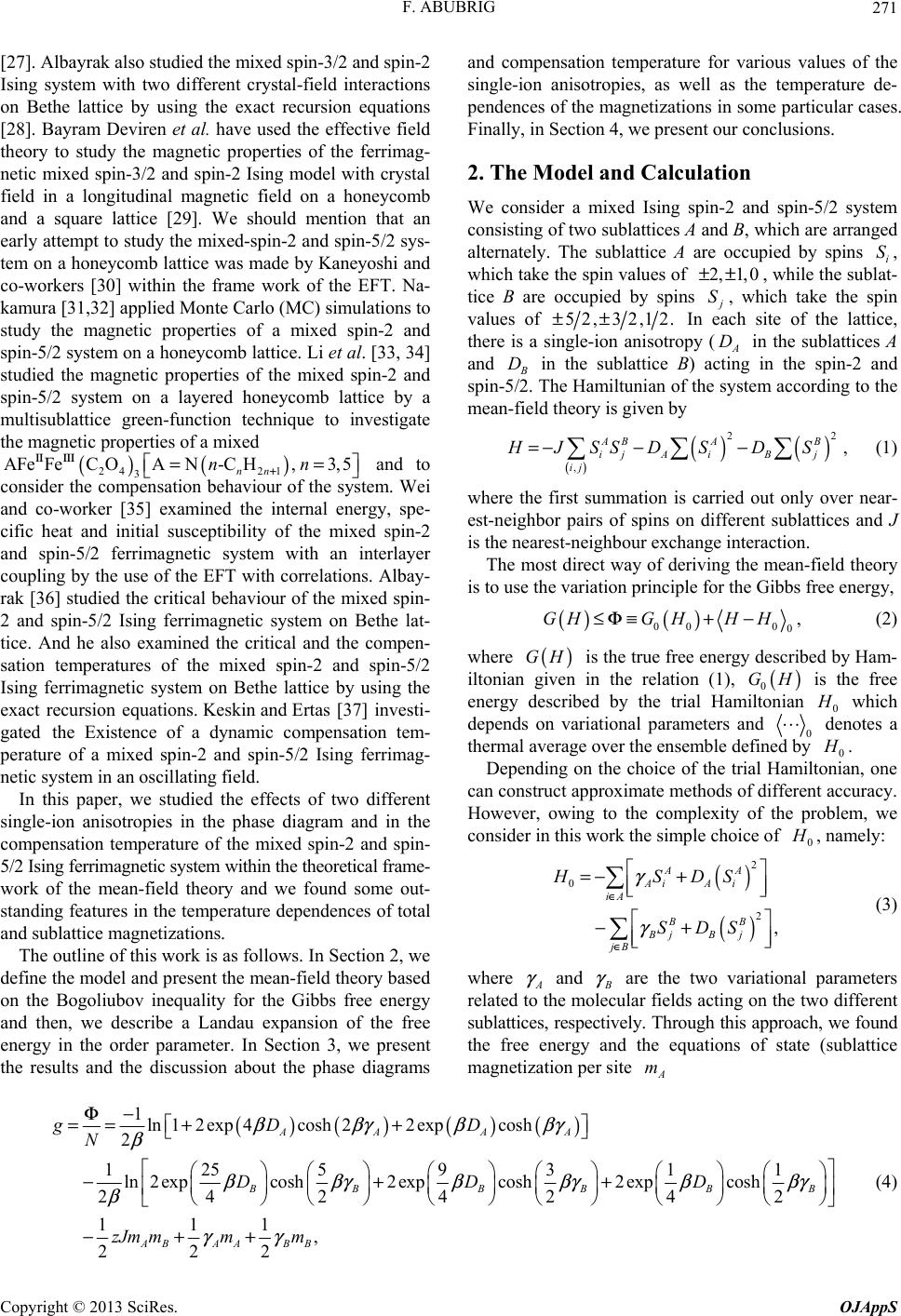 F. ABUBRIG 271 [27]. Albayrak also studied the mixed spin-3/2 and spin-2 Ising system with two different crystal-field interactions on Bethe lattice by using the exact recursion equations [28]. Bayram Deviren et al. have used the effective field theory to study the magnetic properties of the ferrimag- netic mixed spin-3/2 and spin-2 Ising model with crystal field in a longitudinal magnetic field on a honeycomb and a square lattice [29]. We should mention that an early attempt to study the mixed-spin-2 and spin-5/2 sys- tem on a honeycomb lattice was made by Kaneyoshi and co-workers [30] within the frame work of the EFT. Na- kamura [31,32] applied Monte Carlo (MC) simulations to study the magnetic properties of a mixed spin-2 and spin-5/2 system on a honeycomb lattice. Li et al. [33, 34] studied the magnetic properties of the mixed spin-2 and spin-5/2 system on a layered honeycomb lattice by a multisublattice green-function technique to investigate the magnetic properties of a mixed () () 24 21 AFeFeCOAN-CH,3, 5 nn nn ΙΙ ΙΙΙ + == 3 and to consider the compensation behaviour of the system. Wei and co-worker [35] examined the internal energy, spe- cific heat and initial susceptibility of the mixed spin-2 and spin-5/2 ferrimagnetic system with an interlayer coupling by the use of the EFT with correlations. Albay- rak [36] studied the critical behaviour of the mixed spin- 2 and spin-5/2 Ising ferrimagnetic system on Bethe lat- tice. And he also examined the critical and the compen- sation temperatures of the mixed spin-2 and spin-5/2 Ising ferrimagnetic system on Bethe lattice by using the exact recursion equations. Keskin and Ertas [37] investi- gated the Existence of a dynamic compensation tem- perature of a mixed spin-2 and spin-5/2 Ising ferrimag- netic system in an oscillating field. In this paper, we studied the effects of two different single-ion anisotropies in the phase diagram and in the compensation temperature of the mixed spin-2 and spin- 5/2 Ising ferrimagnetic system within the theoretical frame- work of the mean-field theory and we found some out- standing features in the temperature dependences of total and sublattice magnetizations. The outline of this work is as follows. In Section 2, we define the model and present the mean-field theory based on the Bogoliubov inequality for the Gibbs free energy and then, we describe a Landau expansion of the free energy in the order parameter. In Section 3, we present the results and the discussion about the phase diagrams and compensation temperature for various values of the single-ion anisotropies, as well as the temperature de- pendences of the magnetizations in some particular cases. Finally, in Section 4, we present our conclusions. 2. The Model and Calculation We consider a mixed Ising spin-2 and spin-5/2 system consisting of two sublattices A and B, which are arranged alternately. The sublattice A are occupied by spins i, which take the spin values of , while the sublat- tice B are occupied by spins S 2,1, 0±± S, which take the spin values of 52, 32,12.±± In each site of the lattice, there is a single-ion anisotropy (A in the sublattices A and D D in the sublattice B) acting in the spin-2 and spin-5/2. The Hamiltunian of the system according to the mean-field theory is given by () () () 22 , AB AB ij AiBj ij HJSSDS DS=− −− , (1) where the first summation is carried out only over near- est-neighbor pairs of spins on different sublattices and J is the nearest-neighbour exchange interaction. The most direct way of deriving the mean-field theory is to use the variation principle for the Gibbs free energy, () () 00 0 0 GHG HHH≤Φ≡+ −, (2) where is the true free energy described by Ham- iltonian given in the relation (1), is the free energy described by the trial Hamiltonian 0 () GH () 0 GH which depends on variational parameters and 0 denotes a thermal average over the ensemble defined by 0 . Depending on the choice of the trial Hamiltonian, one can construct approximate methods of different accuracy. However, owing to the complexity of the problem, we consider in this work the simple choice of 0 , namely: () () 2 0 2, AA AiA i iA BB BjBj jB HSDS SDS γ γ ∈ ∈ =− + −+ (3) where A and are the two variational parameters related to the molecular fields acting on the two different sublattices, respectively. Through this approach, we found the free energy and the equations of state (sublattice magnetization per site A m ()() ()() 1ln12exp4cosh2 2exp cosh 2 1255 93 11 ln2expcosh 2expcosh 2expcosh 24 24242 111 , 222 AA AA BB BB B ABAA BB gDD N DDD zJmmmm ββγββγ β ββγ ββγ ββ β γγ Φ− == ++ −++ −++ B γ (4) Copyright © 2013 SciRes. OJAppS 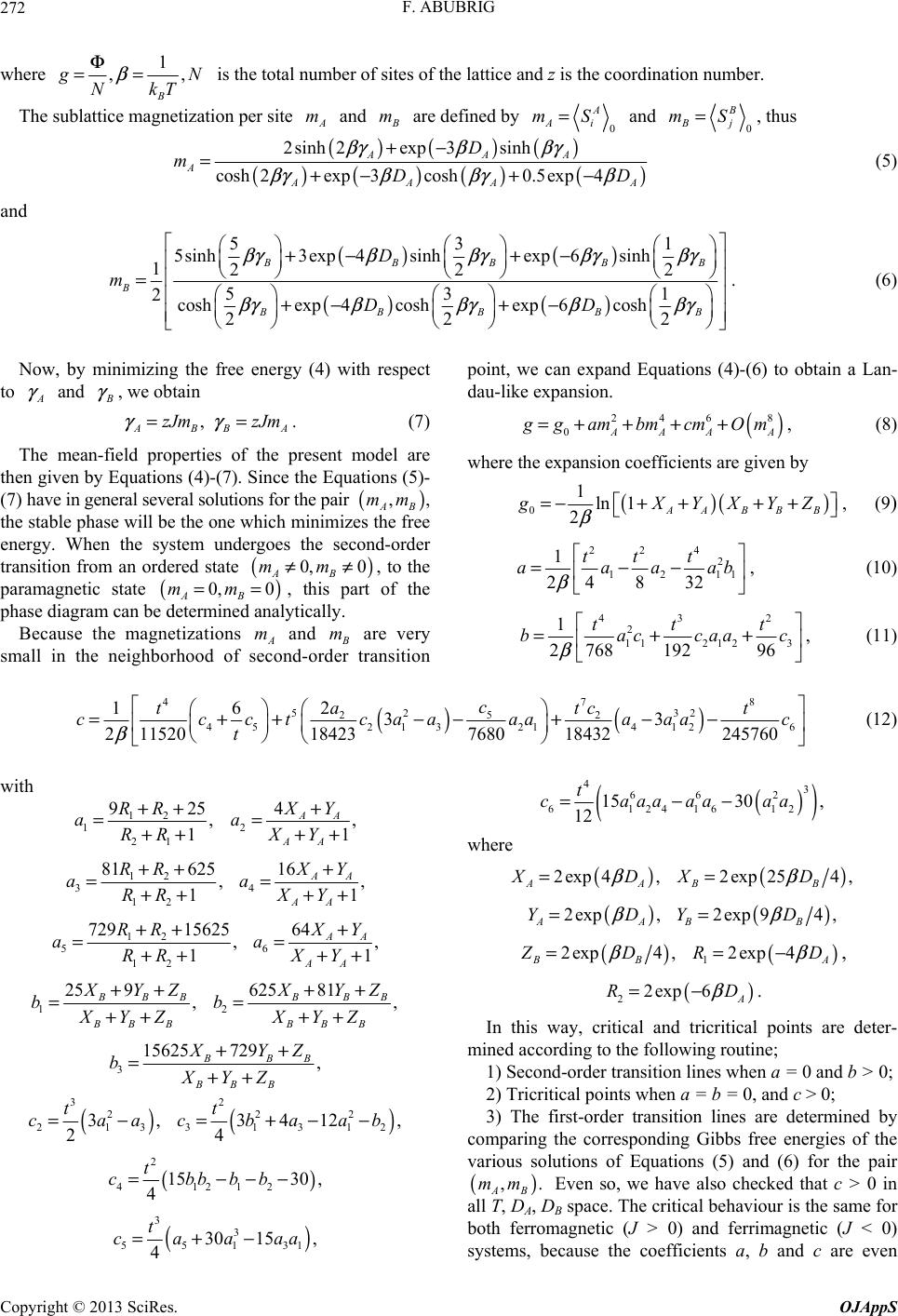 F. ABUBRIG 272 where 1 , B , N NkT β Φ == is the total number of sites of the lattice and z is the coordination number. The sublattice magnetization per site and A m m are defined by 0 A Ai mS= and 0 B Bj mS=, thus ()()() () ()()() 2sinh 2xp3sinh cosh 2exp3cosh0.5exp4 AAA AAAA A D mDD βγβ βγ βγβ βγβ +− =+−+ − e (5) and () () () () 53 5sinh3exp 4sinhexp 6sinh 122 53 2coshexp 4coshexp 6cosh 222 BBBB B BBBB D m DD βγββγβγ βγ βγ ββγ ββγ +− +− = +− +− 1 2 1 B B . (6) Now, by minimizing the free energy (4) with respect to A and , we obtain , ABB zJm zJmA ==. (7) The mean-field properties of the present model are then given by Equations (4)-(7). Since the Equations (5)- (7) have in general several solutions for the pair , the stable phase will be the one which minimizes the free energy. When the system undergoes the second-order transition from an ordered state , to the paramagnetic state AB , this part of the phase diagram can be determined analytically. () , AB mm () 0≠0, AB mm≠ ) 0= ( 0,mm= Because the magnetizations A and m m are very small in the neighborhood of second-order transition point, we can expand Equations (4)-(6) to obtain a Lan- dau-like expansion. ( 2468 0AAA A ) gambmcmOm=++ + +, (8) where the expansion coefficients are given by ()( 0 1ln 1 2AABB B gXYXY β =−+++ + ) Z , (9) 22 4 2 12 1 1 24 8 32 tt t aaaa β 1 b =−− , (10) 43 2 2 11212 3 1 2768 19296 tt t baccaa β c =++ , (11) () () 74 8 52 32 5 22 45213214126 216 33 21152018423 768018432 245760 c atctt ccctcaaaaaaa t β =++ −−+−− c (12) with 12 1 21 925 , 1 RR aRR ++ =++ 2 4, 1 AA AA Y aXY + =++ 12 3 12 81625 , 1 RR aRR ++ =++ 4 16 , 1 AA AA Y aXY + =++ 12 5 12 72915625 , 1 RR aRR ++ =++ 6 64 , 1 AA AA Y aXY + =++ 1 25 9, BB BB B YZ bXYZ ++ =++ 2 625 81, BB BB B YZ bXYZ ++ =++ 3 15625 729, BB BB B YZ bXYZ ++ =++ () 3 2 213 3, 2 t caa=− ( 2 22 3131 3412 4 t cbaab=+−− ) 2 , () 2 41212 1530 , 4 t cbbbb=−−− () 3 3 5513 30 15, 4 t caaaa=+− () () 43 66 2 61241612 1530 , 12 t caaaaaaa=−− where () 2exp 4, AA XD β = () 2 exp254, BB XD β = () 2exp , AA YD β = () 2exp 94 , BB YD β = () 2exp4, BB ZD β = , () 12exp 4A RD β =− () 22exp 6A RD β =− . In this way, critical and tricritical points are deter- mined according to the following routine; 1) Second-order transition lines when a = 0 and b > 0; 2) Tricritical points when a = b = 0, and c > 0; 3) The first-order transition lines are determined by comparing the corresponding Gibbs free energies of the various solutions of Equations (5) and (6) for the pair Even so, we have also checked that c > 0 in all T, DA, DB space. The critical behaviour is the same for both ferromagnetic (J > 0) and ferrimagnetic (J < 0) systems, because the coefficients a, b and c are even ( , AB mm ) . 1 Copyright © 2013 SciRes. OJAppS 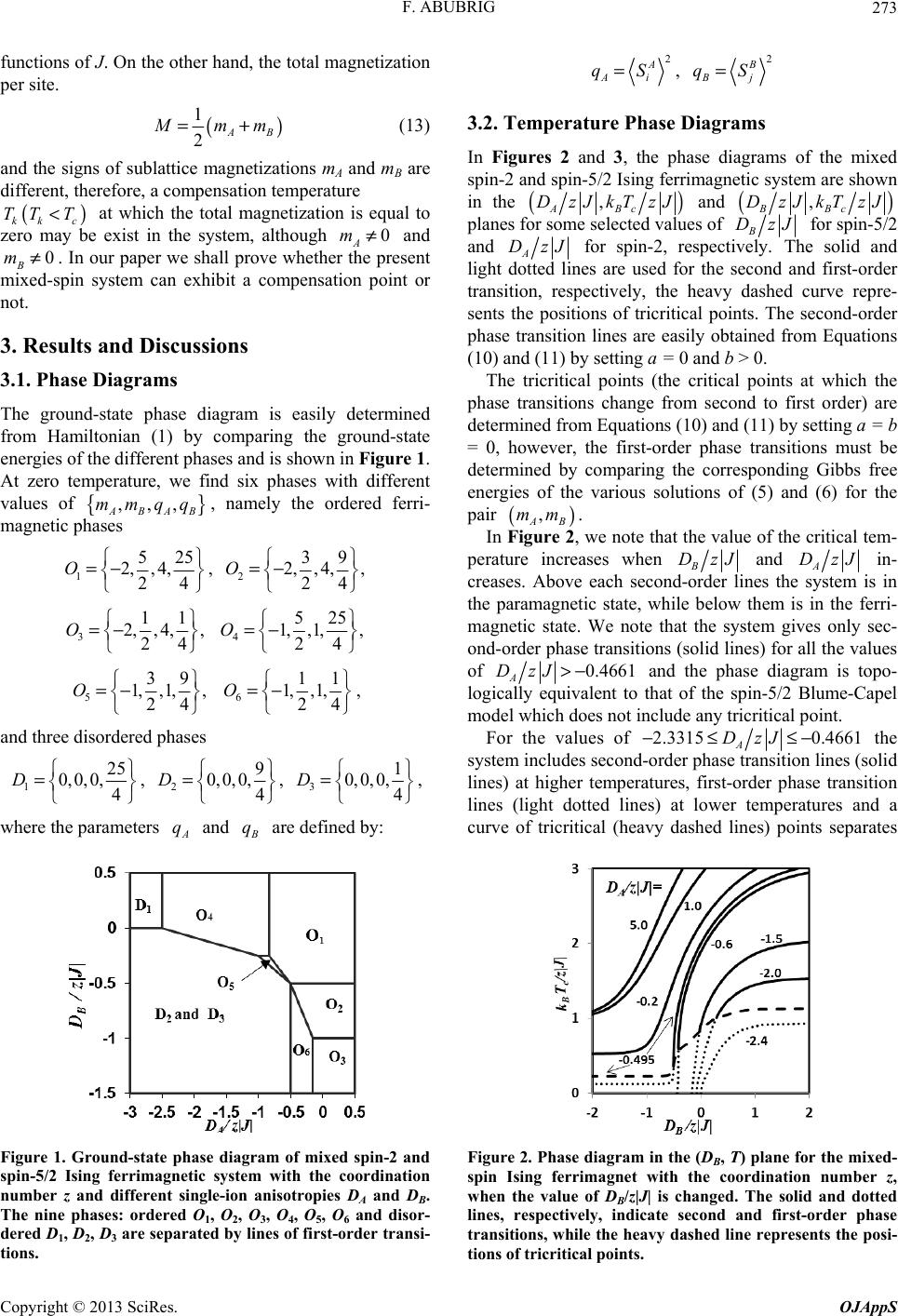 F. ABUBRIG 273 functions of J. On the other hand, the total magnetization per site. ( 1 2AB ) mm=+ (13) and the signs of sublattice magnetizations mA and mB are different, therefore, a compensation temperature at which the total magnetization is equal to zero may be exist in the system, although and . In our paper we shall prove whether the present mixed-spin system can exhibit a compensation point or not. ( kk c TT T< 0 B m≠ ) 0 A m≠ 3. Results and Discussions 3.1. Phase Diagrams The ground-state phase diagram is easily determined from Hamiltonian (1) by comparing the ground-state energies of the different phases and is shown in Figure 1. At zero temperature, we find six phases with different values of ,,, ABAB mmqq , namely the ordered ferri- magnetic phases 1 525 2,,4, 24 O =− , 2 39 2,,4,, 24 O =− 3 11 2,,4,, 24 O =− 4 525 1, ,1,, 24 O =− 5 39 1, ,1,, 24 O =− 6 11 1, ,1, 24 O =− , and three disordered phases 1 25 0, 0,0,4 D = , 2 9 0, 0,0,4 D = , 3 1 0, 0,0,4 D = , where the parameters and A q q are defined by: Figure 1. Ground-state phase diagram of mixed spin-2 and spin-5/2 Ising ferrimagnetic system with the coordination number z and different single-ion anisotropies DA and DB. The nine phases: ordered O1, O2, O3, O4, O5, O6 and disor- dered D1, D2, D3 are separated by lines of first-order transi- tions. 2 A Ai qS=, 2 B Bj qS= 3.2. Temperature Phase Diagrams In Figures 2 and 3, the phase diagrams of the mixed spin-2 and spin-5/2 Ising ferrimagnetic system are shown in the () , ABc DzJkTzJ and () , BBc DzJkTzJ planes for some selected values of B DzJ for spin-5/2 and A DzJ for spin-2, respectively. The solid and light dotted lines are used for the second and first-order transition, respectively, the heavy dashed curve repre- sents the positions of tricritical points. The second-order phase transition lines are easily obtained from Equations (10) and (11) by setting a = 0 and b > 0. The tricritical points (the critical points at which the phase transitions change from second to first order) are determined from Equations (10) and (11) by setting a = b = 0, however, the first-order phase transitions must be determined by comparing the corresponding Gibbs free energies of the various solutions of (5) and (6) for the pair . () , AB mm In Figure 2, we note that the value of the critical tem- perature increases when B DzJ and A DzJ in- creases. Above each second-order lines the system is in the paramagnetic state, while below them is in the ferri- magnetic state. We note that the system gives only sec- ond-order phase transitions (solid lines) for all the values of 0.4661 A DzJ>− and the phase diagram is topo- logically equivalent to that of the spin-5/2 Blume-Capel model which does not include any tricritical point. For the values of 2.3315 0.4661 A DzJ−≤ ≤− the system includes second-order phase transition lines (solid lines) at higher temperatures, first-order phase transition lines (light dotted lines) at lower temperatures and a curve of tricritical (heavy dashed lines) points separates Figure 2. Phase diagram in the (DB, T) plane for the mixed- spin Ising ferrimagnet with the coordination number z, when the value of DB/z|J| is changed. The solid and dotted lines, respectively, indicate second and first-order phase transitions, while the heavy dashed line represents the posi- tions of tricritical points. Copyright © 2013 SciRes. OJAppS 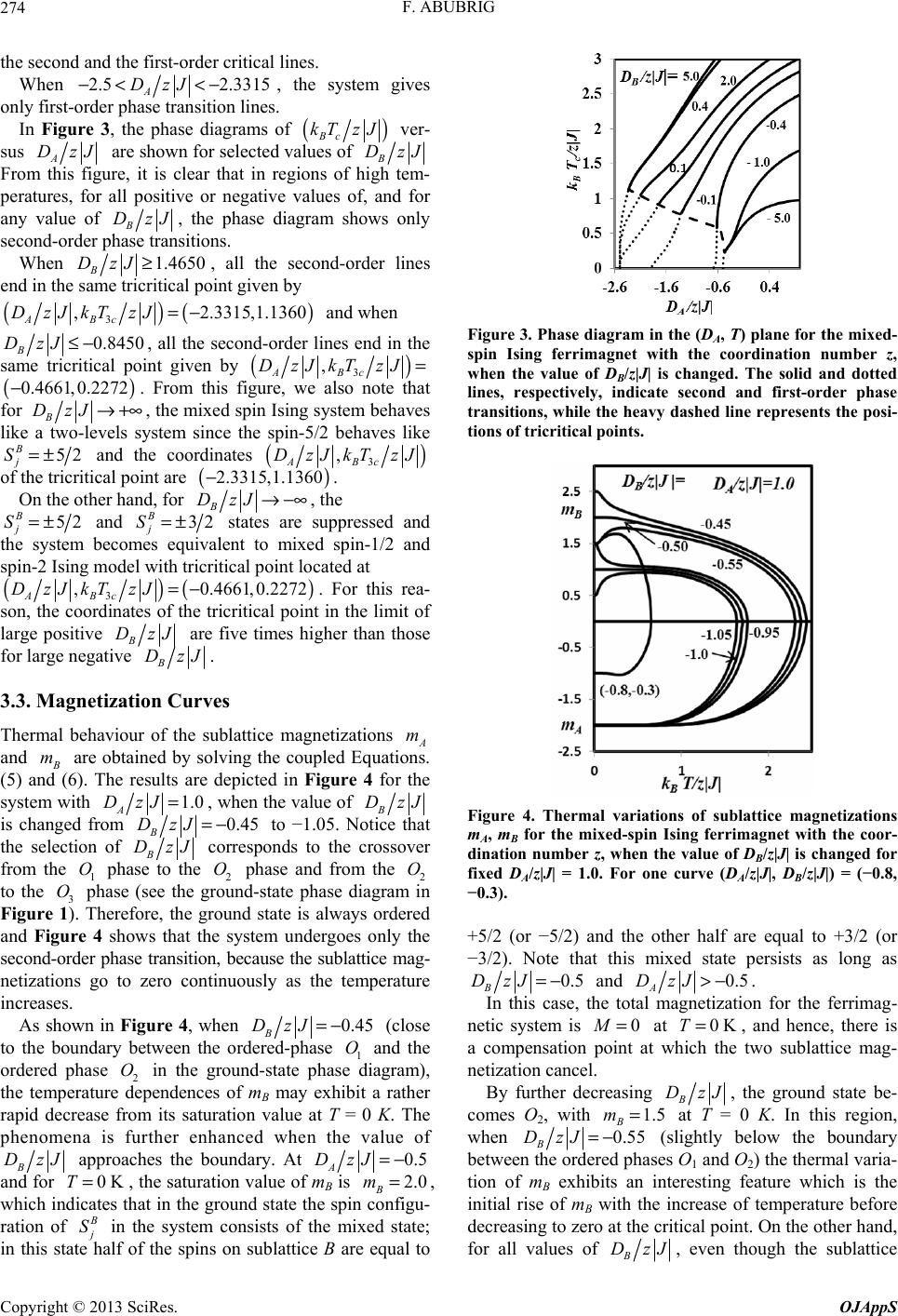 F. ABUBRIG 274 the second and the first-order critical lines. When 2.5 2.3315 A DzJ−<<−, the system gives only first-order phase transition lines. In Figure 3, the phase diagrams of () Bc kTzJ ver- sus A DzJ are shown for selected values of B DzJ From this figure, it is clear that in regions of high tem- peratures, for all positive or negative values of, and for any value of B DzJ, the phase diagram shows only second-order phase transitions. When 1.4650 B DzJ≥, all the second-order lines end in the same tricritical point given by () () 3 , 2.3315,1.1360 ABc DzJkTzJ=− and when 0.8450 B DzJ≤− , all the second-order lines end in the same tricritical point given by ( 3 , ABc DzJkTzJ= ) ) . From this figure, we also note that for ( 0.4661,0.2272− B DzJ→+∞, the mixed spin Ising system behaves like a two-levels system since the spin-5/2 behaves like 52 B j S=± and the coordinates () 3 , ABc DzJkTzJ of the tricritical point are . () 2.3315,1.1 360− On the other hand, for B DzJ→−∞, the 52 B j S=± and 32 B j S=± states are suppressed and the system becomes equivalent to mixed spin-1/2 and spin-2 Ising model with tricritical point located at () ( 3 , 0.4661,0.2272 ABc DzJkTzJ=− ) . For this rea- son, the coordinates of the tricritical point in the limit of large positive B DzJ are five times higher than those for large negative B DzJ. 3.3. Magnetization Curves Thermal behaviour of the sublattice magnetizations A and m m are obtained by solving the coupled Equations. (5) and (6). The results are depicted in Figure 4 for the system with 1.0 A DzJ=, when the value of B DzJ is changed from 0.45 B DzJ=− to −1.05. Notice that the selection of B DzJ corresponds to the crossover from the 1 phase to the 2 phase and from the 2 to the 3 phase (see the ground-state phase diagram in Figure 1). Therefore, the ground state is always ordered and Figure 4 shows that the system undergoes only the second-order phase transition, because the sublattice mag- netizations go to zero continuously as the temperature increases. O OO O As shown in Figure 4, when 0.45 B DzJ=− (close to the boundary between the ordered-phase 1 and the ordered phase 2 in the ground-state phase diagram), the temperature dependences of mB may exhibit a rather rapid decrease from its saturation value at T = 0 K. The phenomena is further enhanced when the value of O O B DzJ approaches the boundary. At 0.5 A DzJ=− and for , the saturation value of mB is , which indicates that in the ground state the spin configu- ration of 0KT=2.0 B m= S in the system consists of the mixed state; in this state half of the spins on sublattice B are equal to Figure 3. Phase diagram in the (DA, T) plane for the mixed- spin Ising ferrimagnet with the coordination number z, when the value of DB/z|J| is changed. The solid and dotted lines, respectively, indicate second and first-order phase transitions, while the heavy dashed line represents the posi- tions of tricritical points. Figure 4. Thermal variations of sublattice magnetizations mA, mB for the mixed-spin Ising ferrimagnet with the coor- dination number z, when the value of DB/z|J| is changed for fixed DA/z|J| = 1.0. For one curve (DA/z|J|, DB/z|J|) = (−0.8, −0.3). +5/2 (or −5/2) and the other half are equal to +3/2 (or −3/2). Note that this mixed state persists as long as 0.5 B DzJ=− and 0.5 A DzJ>− . In this case, the total magnetization for the ferrimag- netic system is at , and hence, there is a compensation point at which the two sublattice mag- netization cancel. 0M=0KT= By further decreasing B DzJ, the ground state be- comes O2, with at T = 0 K. In this region, when 1.5 B m= 0.55=− B (slightly below the boundary between the ordered phases O1 and O2) the thermal varia- tion of mB exhibits an interesting feature which is the initial rise of mB with the increase of temperature before decreasing to zero at the critical point. On the other hand, for all values of DzJ B DzJ, even though the sublattice Copyright © 2013 SciRes. OJAppS 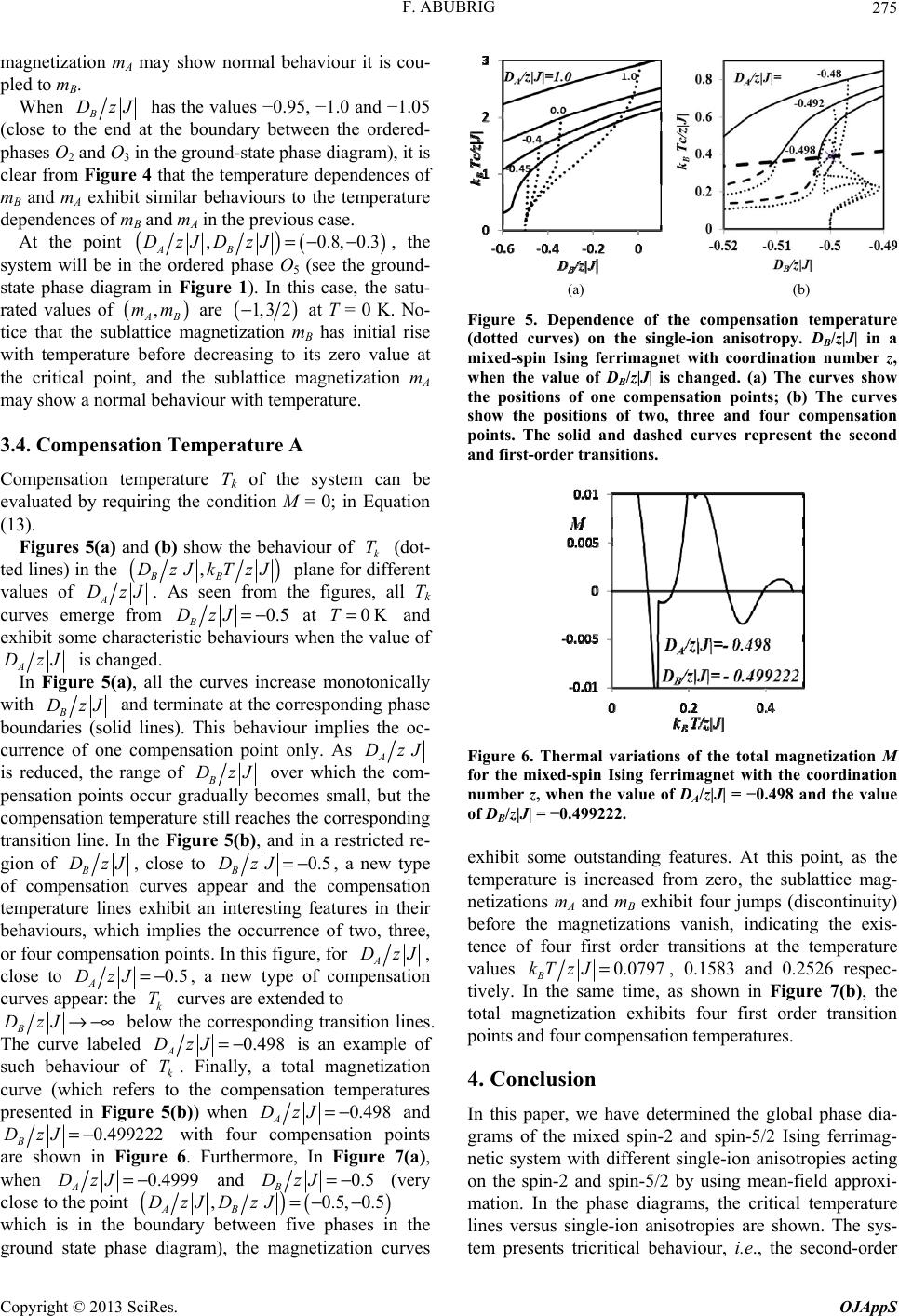 F. ABUBRIG 275 magnetization mA may show normal behaviour it is cou- pled to mB. When B DzJ has the values −0.95, −1.0 and −1.05 (close to the end at the boundary between the ordered- phases O2 and O3 in the ground-state phase diagram), it is clear from Figure 4 that the temperature dependences of mB and mA exhibit similar behaviours to the temperature dependences of mB and mA in the previous case. At the point () () ,0.8, AB DzJDzJ=− −0.3, the system will be in the ordered phase O5 (see the ground- state phase diagram in Figure 1). In this case, the satu- rated values of are () , AB mm ( 1, 32− ) at T = 0 K. No- tice that the sublattice magnetization mB has initial rise with temperature before decreasing to its zero value at the critical point, and the sublattice magnetization mA may show a normal behaviour with temperature. 3.4. Compensation Temperature A Compensation temperature Tk of the system can be evaluated by requiring the condition M = 0; in Equation (13). Figures 5(a) and (b) show the behaviour of k (dot- ted lines) in the T ( , BB DzJkTzJ ) plane for different values of A DzJ . As seen from the figures, all Tk curves emerge from 0.5 B DzJ=− at and exhibit some characteristic behaviours when the value of 0KT= A DzJ is changed. In Figure 5(a), all the curves increase monotonically with B DzJ and terminate at the corresponding phase boundaries (solid lines). This behaviour implies the oc- currence of one compensation point only. As A DzJ is reduced, the range of B DzJ over which the com- pensation points occur gradually becomes small, but the compensation temperature still reaches the corresponding transition line. In the Figure 5(b), and in a restricted re- gion of B DzJ, close to 0.5 B DzJ=− , a new type of compensation curves appear and the compensation temperature lines exhibit an interesting features in their behaviours, which implies the occurrence of two, three, or four compensation points. In this figure, for A DzJ, close to 0.5 A DzJ=− , a new type of compensation curves appear: the curves are extended to k T B DzJ→−∞ below the corresponding transition lines. The curve labeled 0.498 A DzJ=− is an example of such behaviour of k T. Finally, a total magnetization curve (which refers to the compensation temperatures presented in Figure 5(b)) when 0.498 A DzJ=− and 0.499222 B with four compensation points are shown in Figure 6. Furthermore, In Figure 7(a), when DzJ=− 0.4999DzJ=− A and 0.5 B DzJ=− (very close to the point () () ,0.5,0.5DzJDzJ=− − AB which is in the boundary between five phases in the ground state phase diagram), the magnetization curves (a) (b) Figure 5. Dependence of the compensation temperature (dotted curves) on the single-ion anisotropy. D B/z|J| in a mixed-spin Ising ferrimagnet with coordination number z, when the value of DB/z|J| is changed. (a) The curves show the positions of one compensation points; (b) The curves show the positions of two, three and four compensation points. The solid and dashed curves represent the second and first-order transitions. Figure 6. Thermal variations of the total magnetization M for the mixed-spin Ising ferrimagnet with the coordination number z, when the value of DA/z|J| = −0.498 and the value of DB/z|J| = −0.499222. exhibit some outstanding features. At this point, as the temperature is increased from zero, the sublattice mag- netizations mA and mB exhibit four jumps (discontinuity) before the magnetizations vanish, indicating the exis- tence of four first order transitions at the temperature values 0.0797 B kT zJ=, 0.1583 and 0.2526 respec- tively. In the same time, as shown in Figure 7(b), the total magnetization exhibits four first order transition points and four compensation temperatures. 4. Conclusion In this paper, we have determined the global phase dia- grams of the mixed spin-2 and spin-5/2 Ising ferrimag- netic system with different single-ion anisotropies acting on the spin-2 and spin-5/2 by using mean-field approxi- mation. In the phase diagrams, the critical temperature lines versus single-ion anisotropies are shown. The sys- tem presents tricritical behaviour, i.e., the second-order Copyright © 2013 SciRes. OJAppS 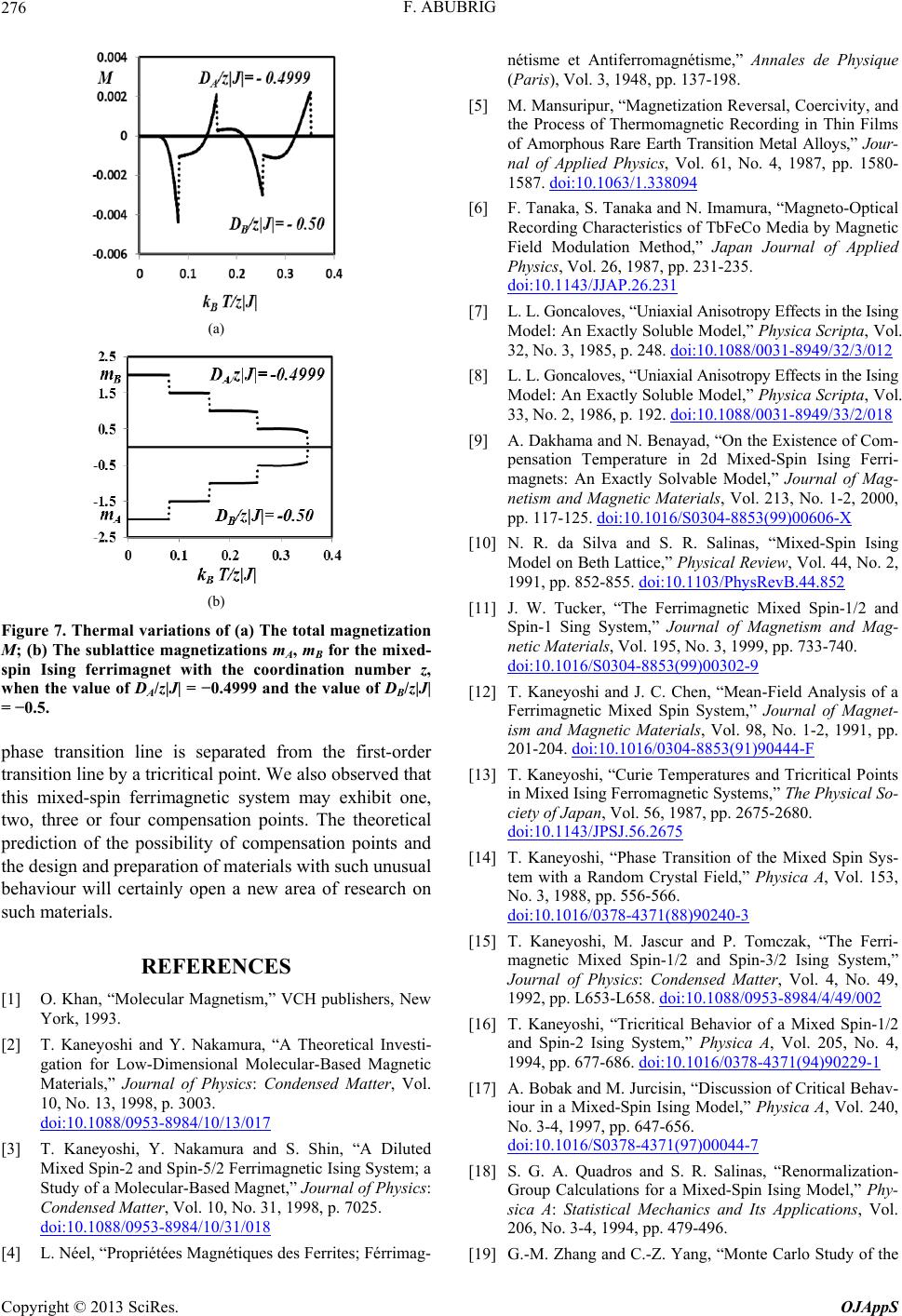 F. ABUBRIG 276 (a) (b) Figure 7. Thermal variations of (a) The total magnetization M; (b) The sublattice magnetizations mA, mB for the mixed- spin Ising ferrimagnet with the coordination number z, when the value of DA/z|J| = −0.4999 and the value of DB/z|J| = −0.5. phase transition line is separated from the first-order transition line by a tricritical point. We also observed that this mixed-spin ferrimagnetic system may exhibit one, two, three or four compensation points. The theoretical prediction of the possibility of compensation points and the design and preparation of materials with such unusual behaviour will certainly open a new area of research on such materials. REFERENCES [1] O. Khan, “Molecular Magnetism,” VCH publishers, New York, 1993. [2] T. Kaneyoshi and Y. Nakamura, “A Theoretical Investi- gation for Low-Dimensional Molecular-Based Magnetic Materials,” Journal of Physics: Condensed Matter, Vol. 10, No. 13, 1998, p. 3003. doi:10.1088/0953-8984/10/13/017 [3] T. Kaneyoshi, Y. Nakamura and S. Shin, “A Diluted Mixed Spin-2 and Spin-5/2 Ferrimagnetic Ising System; a Study of a Molecular-Based Magnet,” Journal of Physics: Condensed Matter, Vol. 10, No. 31, 1998, p. 7025. doi:10.1088/0953-8984/10/31/018 [4] L. Néel, “Propriétées Magnétiques des Ferrites; Férrimag- nétisme et Antiferromagnétisme,” Annales de Physique (Paris), Vol. 3, 1948, pp. 137-198. [5] M. Mansuripur, “Magnetization Reversal, Coercivity, and the Process of Thermomagnetic Recording in Thin Films of Amorphous Rare Earth Transition Metal Alloys,” Jour- nal of Applied Physics, Vol. 61, No. 4, 1987, pp. 1580- 1587. doi:10.1063/1.338094 [6] F. Tanaka, S. Tanaka and N. Imamura, “Magneto-Optical Recording Characteristics of TbFeCo Media by Magnetic Field Modulation Method,” Japan Journal of Applied Physics, Vol. 26, 1987, pp. 231-235. doi:10.1143/JJAP.26.231 [7] L. L. Goncaloves, “Uniaxial Anisotropy Effects in the Ising Model: An Exactly Soluble Model,” Physica Scripta, Vol. 32, No. 3, 1985, p. 248. doi:10.1088/0031-8949/32/3/012 [8] L. L. Goncaloves, “Uniaxial Anisotropy Effects in the Ising Model: An Exactly Soluble Model,” Physica Scripta, Vol. 33, No. 2, 1986, p. 192. doi:10.1088/0031-8949/33/2/018 [9] A. Dakhama and N. Benayad, “On the Existence of Com- pensation Temperature in 2d Mixed-Spin Ising Ferri- magnets: An Exactly Solvable Model,” Journal of Mag- netism and Magnetic Materials, Vol. 213, No. 1-2, 2000, pp. 117-125. doi:10.1016/S0304-8853(99)00606-X [10] N. R. da Silva and S. R. Salinas, “Mixed-Spin Ising Model on Beth Lattice,” Physical Review, Vol. 44, No. 2, 1991, pp. 852-855. doi:10.1103/PhysRevB.44.852 [11] J. W. Tucker, “The Ferrimagnetic Mixed Spin-1/2 and Spin-1 Sing System,” Journal of Magnetism and Mag- netic Materials, Vol. 195, No. 3, 1999, pp. 733-740. doi:10.1016/S0304-8853(99)00302-9 [12] T. Kaneyoshi and J. C. Chen, “Mean-Field Analysis of a Ferrimagnetic Mixed Spin System,” Journal of Magnet- ism and Magnetic Materials, Vol. 98, No. 1-2, 1991, pp. 201-204. doi:10.1016/0304-8853(91)90444-F [13] T. Kaneyoshi, “Curie Temperatures and Tricritical Points in Mixed Ising Ferromagnetic Systems,” The Physical So- ciety of Japan, Vol. 56, 1987, pp. 2675-2680. doi:10.1143/JPSJ.56.2675 [14] T. Kaneyoshi, “Phase Transition of the Mixed Spin Sys- tem with a Random Crystal Field,” Physica A, Vol. 153, No. 3, 1988, pp. 556-566. doi:10.1016/0378-4371(88)90240-3 [15] T. Kaneyoshi, M. Jascur and P. Tomczak, “The Ferri- magnetic Mixed Spin-1/2 and Spin-3/2 Ising System,” Journal of Physics: Condensed Matter, Vol. 4, No. 49, 1992, pp. L653-L658. doi:10.1088/0953-8984/4/49/002 [16] T. Kaneyoshi, “Tricritical Behavior of a Mixed Spin-1/2 and Spin-2 Ising System,” Physica A, Vol. 205, No. 4, 1994, pp. 677-686. doi:10.1016/0378-4371(94)90229-1 [17] A. Bobak and M. Jurcisin, “Discussion of Critical Behav- iour in a Mixed-Spin Ising Model,” Physica A, Vol. 240, No. 3-4, 1997, pp. 647-656. doi:10.1016/S0378-4371(97)00044-7 [18] S. G. A. Quadros and S. R. Salinas, “Renormalization- Group Calculations for a Mixed-Spin Ising Model,” Phy- sica A: Statistical Mechanics and Its Applications, Vol. 206, No. 3-4, 1994, pp. 479-496. [19] G.-M. Zhang and C.-Z. Yang, “Monte Carlo Study of the Copyright © 2013 SciRes. OJAppS 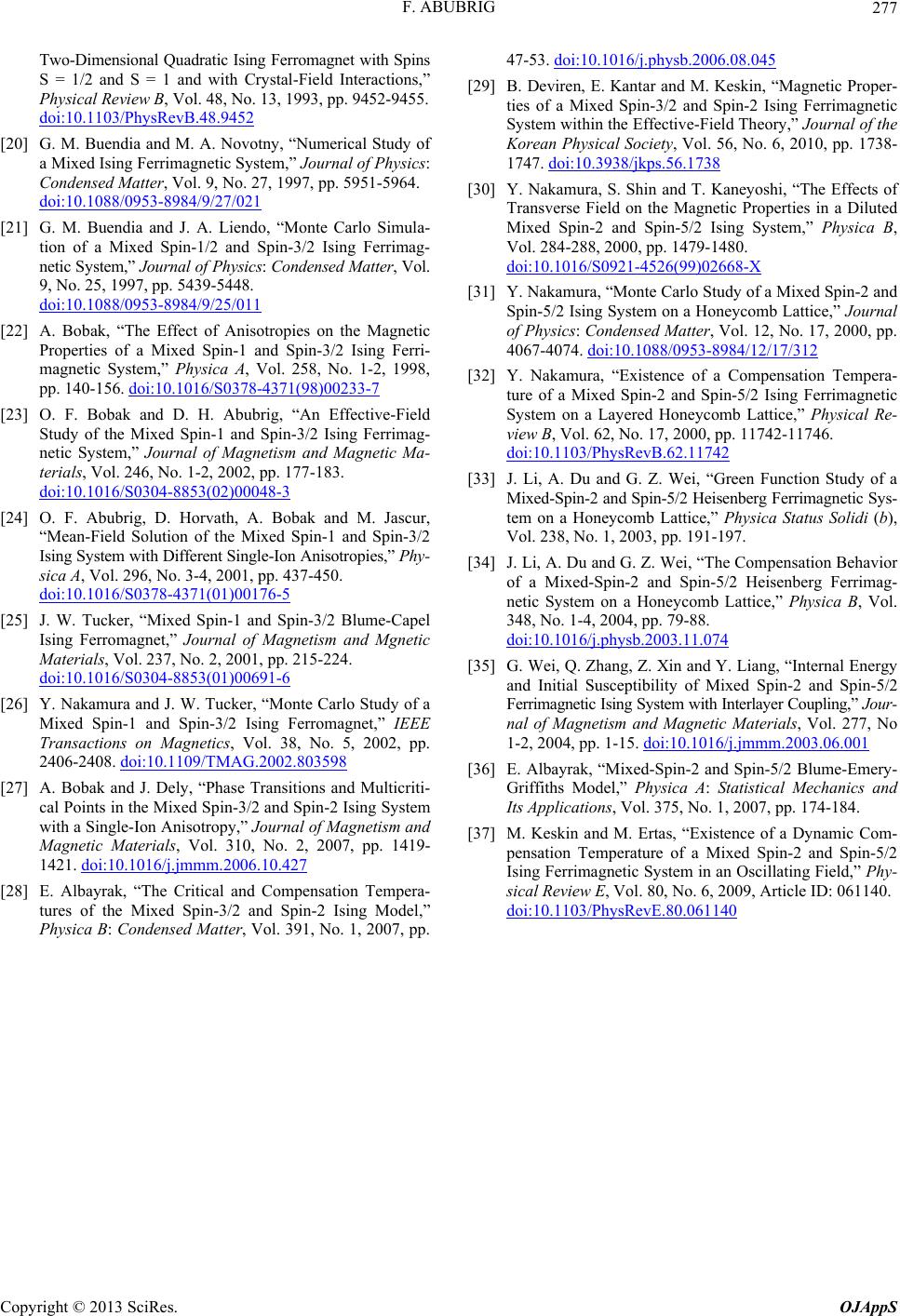 F. ABUBRIG Copyright © 2013 SciRes. OJAppS 277 Two-Dimensional Quadratic Ising Ferromagnet with Spins S = 1/2 and S = 1 and with Crystal-Field Interactions,” Physical Review B, Vol. 48, No. 13, 1993, pp. 9452-9455. doi:10.1103/PhysRevB.48.9452 [20] G. M. Buendia and M. A. Novotny, “Numerical Study of a Mixed Ising Ferrimagnetic System,” Journal of Physics: Condensed Matter, Vol. 9, No. 27, 1997, pp. 5951-5964. doi:10.1088/0953-8984/9/27/021 [21] G. M. Buendia and J. A. Liendo, “Monte Carlo Simula- tion of a Mixed Spin-1/2 and Spin-3/2 Ising Ferrimag- netic System,” Journal of Physic s: Condensed Matter, Vol. 9, No. 25, 1997, pp. 5439-5448. doi:10.1088/0953-8984/9/25/011 [22] A. Bobak, “The Effect of Anisotropies on the Magnetic Properties of a Mixed Spin-1 and Spin-3/2 Ising Ferri- magnetic System,” Physica A, Vol. 258, No. 1-2, 1998, pp. 140-156. doi:10.1016/S0378-4371(98)00233-7 [23] O. F. Bobak and D. H. Abubrig, “An Effective-Field Study of the Mixed Spin-1 and Spin-3/2 Ising Ferrimag- netic System,” Journal of Magnetism and Magnetic Ma- terials, Vol. 246, No. 1-2, 2002, pp. 177-183. doi:10.1016/S0304-8853(02)00048-3 [24] O. F. Abubrig, D. Horvath, A. Bobak and M. Jascur, “Mean-Field Solution of the Mixed Spin-1 and Spin-3/2 Ising System with Different Single-Ion Anisotropies,” Phy- sica A, Vol. 296, No. 3-4, 2001, pp. 437-450. doi:10.1016/S0378-4371(01)00176-5 [25] J. W. Tucker, “Mixed Spin-1 and Spin-3/2 Blume-Capel Ising Ferromagnet,” Journal of Magnetism and Mgnetic Materials, Vol. 237, No. 2, 2001, pp. 215-224. doi:10.1016/S0304-8853(01)00691-6 [26] Y. Nakamura and J. W. Tucker, “Monte Carlo Study of a Mixed Spin-1 and Spin-3/2 Ising Ferromagnet,” IEEE Transactions on Magnetics, Vol. 38, No. 5, 2002, pp. 2406-2408. doi:10.1109/TMAG.2002.803598 [27] A. Bobak and J. Dely, “Phase Transitions and Multicriti- cal Points in the Mixed Spin-3/2 and Spin-2 Ising System with a Single-Ion Anisotropy,” Journal of Magnetism and Magnetic Materials, Vol. 310, No. 2, 2007, pp. 1419- 1421. doi:10.1016/j.jmmm.2006.10.427 [28] E. Albayrak, “The Critical and Compensation Tempera- tures of the Mixed Spin-3/2 and Spin-2 Ising Model,” Physica B: Condensed Matter, Vol. 391, No. 1, 2007, pp. 47-53. doi:10.1016/j.physb.2006.08.045 [29] B. Deviren, E. Kantar and M. Keskin, “Magnetic Proper- ties of a Mixed Spin-3/2 and Spin-2 Ising Ferrimagnetic System within the Effective-Field Theory,” Journal of the Korean Physical Society, Vol. 56, No. 6, 2010, pp. 1738- 1747. doi:10.3938/jkps.56.1738 [30] Y. Nakamura, S. Shin and T. Kaneyoshi, “The Effects of Transverse Field on the Magnetic Properties in a Diluted Mixed Spin-2 and Spin-5/2 Ising System,” Physica B, Vol. 284-288, 2000, pp. 1479-1480. doi:10.1016/S0921-4526(99)02668-X [31] Y. Nakamura, “Monte Carlo Study of a Mixed Spin-2 and Spin-5/2 Ising System on a Honeycomb Lattice,” Journal of Physics: Condensed Matter, Vol. 12, No. 17, 2000, pp. 4067-4074. doi:10.1088/0953-8984/12/17/312 [32] Y. Nakamura, “Existence of a Compensation Tempera- ture of a Mixed Spin-2 and Spin-5/2 Ising Ferrimagnetic System on a Layered Honeycomb Lattice,” Physical Re- view B, Vol. 62, No. 17, 2000, pp. 11742-11746. doi:10.1103/PhysRevB.62.11742 [33] J. Li, A. Du and G. Z. Wei, “Green Function Study of a Mixed-Spin-2 and Spin-5/2 Heisenberg Ferrimagnetic Sys- tem on a Honeycomb Lattice,” Physica Status Solidi (b), Vol. 238, No. 1, 2003, pp. 191-197. [34] J. Li, A. Du and G. Z. Wei, “The Compensation Behavior of a Mixed-Spin-2 and Spin-5/2 Heisenberg Ferrimag- netic System on a Honeycomb Lattice,” Physica B, Vol. 348, No. 1-4, 2004, pp. 79-88. doi:10.1016/j.physb.2003.11.074 [35] G. Wei, Q. Zhang, Z. Xin and Y. Liang, “Internal Energy and Initial Susceptibility of Mixed Spin-2 and Spin-5/2 Ferrimagnetic Ising System with Interlayer Coupling,” Jour- nal of Magnetism and Magnetic Materials, Vol. 277, No 1-2, 2004, pp. 1-15. doi:10.1016/j.jmmm.2003.06.001 [36] E. Albayrak, “Mixed-Spin-2 and Spin-5/2 Blume-Emery- Griffiths Model,” Physica A: Statistical Mechanics and Its Applications, Vol. 375, No. 1, 2007, pp. 174-184. [37] M. Keskin and M. Ertas, “Existence of a Dynamic Com- pensation Temperature of a Mixed Spin-2 and Spin-5/2 Ising Ferrimagnetic System in an Oscillating Field,” Phy- sical Review E, Vol. 80, No. 6, 2009, Article ID: 061140. doi:10.1103/PhysRevE.80.061140
|